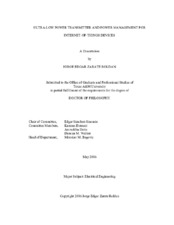| dc.contributor.advisor | Sanchez-Sinencio, Edgar | |
| dc.creator | Zarate Roldan, Jorge Edgar | |
| dc.date.accessioned | 2016-07-08T15:08:01Z | |
| dc.date.available | 2018-05-01T05:48:57Z | |
| dc.date.created | 2016-05 | |
| dc.date.issued | 2016-01-27 | |
| dc.date.submitted | May 2016 | |
| dc.identifier.uri | https://hdl.handle.net/1969.1/156849 | |
| dc.description.abstract | Two of the most critical components in an Internet-of-Things (IoT) sensing and transmitting node are the power management unit (PMU) and the wireless transmitter (Tx). The desire for longer intervals between battery replacements or a completely self-contained, battery-less operation via energy harvesting transducers and circuits in IoT nodes demands highly efficient integrated circuits. This dissertation addresses the challenge of designing and implementing power management and Tx circuits with ultra-low power consumption to enable such efficient operation.
The first part of the dissertation focuses on the study and design of power management circuits for IoT nodes. This opening portion elaborates on two different areas of the power management field: Firstly, a low-complexity, SPICE-based model for general low dropout (LDO) regulators is demonstrated. The model aims to reduce the stress and computation times in the final stages of simulation and verification of Systems-on-Chip (SoC), including IoT nodes, that employ large numbers of LDOs. Secondly, the implementation of an efficient PMU for an energy harvesting system based on a thermoelectric generator transducer is discussed. The PMU includes a first-in-its-class LDO with programmable supply noise rejection for localized improvement in the suppression.
The second part of the dissertation addresses the challenge of designing an ultra-
low power wireless FSK Tx in the 900 MHz ISM band. To reduce the power consumption and boost the Tx energy efficiency, a novel delay cell exploiting current reuse is used in a ring-oscillator employed as the local oscillator generator scheme. In combination with an edge-combiner PA, the Tx showed a measured energy efficiency of 0.2 nJ/bit and a normalized energy efficiency of 3.1 nJ/(bit∙mW) when operating at output power levels up to -10 dBm and data rates of 3 Mbps. To close this dissertation, the implementation of a supply-noise tolerant BiCMOS ring-oscillator is discussed. The combination of a passive, high-pass feedforward path from the supply to critical nodes in the selected delay cell and a low cost LDO allow the oscillator to exhibit power supply noise rejection levels better than –33 dB in experimental results. | en |
| dc.format.mimetype | application/pdf | |
| dc.language.iso | en | |
| dc.subject | Internet-of-Things | en |
| dc.subject | Wireless Transmitter | en |
| dc.subject | Power Management Circuits | en |
| dc.title | Ultra-Low Power Transmitter and Power Management for Internet-of-Things Devices | en |
| dc.type | Thesis | en |
| thesis.degree.department | Electrical and Computer Engineering | en |
| thesis.degree.discipline | Electrical Engineering | en |
| thesis.degree.grantor | Texas A & M University | en |
| thesis.degree.name | Doctor of Philosophy | en |
| thesis.degree.level | Doctoral | en |
| dc.contributor.committeeMember | Entesari, Kamran | |
| dc.contributor.committeeMember | Datta, Aniruddha | |
| dc.contributor.committeeMember | Walker, Duncan M | |
| dc.type.material | text | en |
| dc.date.updated | 2016-07-08T15:08:02Z | |
| local.embargo.terms | 2018-05-01 | |
| local.etdauthor.orcid | 0000-0002-4209-2025 | |


